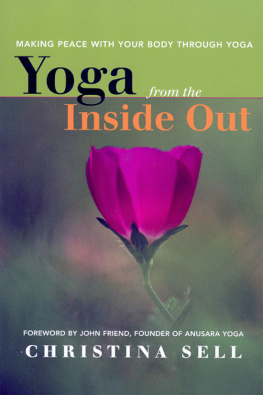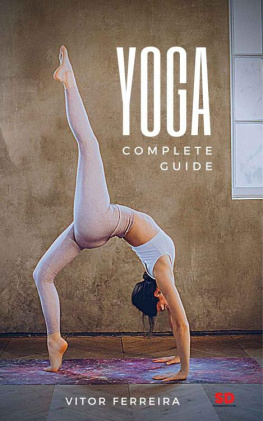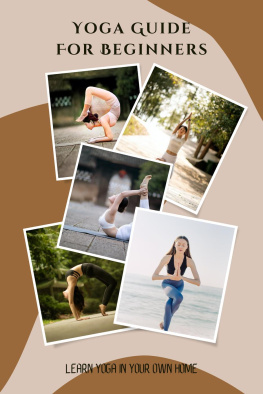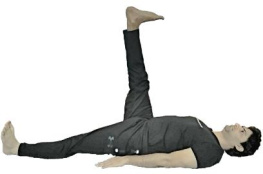
Acknowledgments
To adequately acknowledge all of the love and support that have contributed to the writing of this book is an impossible task. Be that as it may, here goes. I offer my gratitude and a very special thanks to:
Lee Lozowick, for, well, Everything.
John Friend, for believing in me and for helping me to be strong and soft. You rock.
Desiree Rumbaugh, for showing me how much fun it is to practice yoga. You are a great teacher and a great friend.
Manouso Manos, for pointing the way.
My husband, Kelly, for being my best friend. I love you. Thank you for being a great photographer and for helping all of the models feel beautiful. Thank you for knowing when I had to write and understanding when I couldnt play. Thank you for loving me.
My sangha-mates, for Refuge.
The Anusara Yoga Kula, for the absolutely incredible ways that you lift me up out of my self-centered suffering and for the laughter.
My yoga students, for inspiring me to live up to what I am teaching. Thanks for sharing the journey with me.
Everyone who shared their story with me. Whether or not your interview is technically in print, I used every conversation I have had on the subject to write this book. Thank you for your willingness to be vulnerable and to reveal yourselves so thoughtfully.
The models who posed for the pictures, for your commitment to the project and for loving yourselves. Your beauty is blinding.
Allison and Howard Kravetz for your personal and professional support. Your friendship is a blessing.
My editor and mentor, Regina Sara Ryan, for all you continue to teach me about communication. I think you are the coolest.
CHAPTER ONE 
War and Peace

I was six when my best friends brother sexually abused me. Over a period of several months he and his friends involved me and his sister in sexual fondling, games of a sexual nature, and watching pornographic films. I never said no nor did I ever tell anyone about what was happening. I understood these events to be a secret and I experienced the confusion of feeling physical pleasure concurrent with the shame and fear typical of children who are sexually abused. Over time I kept the abuse a secret, even from myself, as these memories were hidden from me until my early adulthood.
I was the youngest child in a family that placed a tremendous emphasis on being thin and on watching ones weight. I was a physically small child. My older sister, Anne-Marie was round and soft in her physique. Our parents put Anne-Marie on a diet when she was nine. My interpretation of these dynamics was that thin was good, fat was bad. I assumed I would be more lovable if I stayed thin.
Being intelligent, logical and highly verbal, I was successful academically. Being small and physically coordinated, I was naturally suited for gymnastics, and also participated in dance, soccer, softball, and violin and piano lessons. During pre-adolescence, competing in gymnastics at the state level, I first learned to push past my bodys limits, to ignore my pain and to pursue perfection through the physical body. (In retrospect, I have no idea why we were pushed so hard as young gymnasts. We were already past the age where Olympic competition was possible and clearly this was an extra curricular activity, nothing else.) During this time, on the physical level, I dealt with various over-training injuries, ripped calluses on my hands, constantly sore muscles, sprains, bruises, and aches. I even broke my front tooth in practice. Emotionally, I learned to pursue perfect scores. I grew accustomed to competing with other girls for the coachs attention and for the judges approval. I learned that thin and cute was better than plain and heavy. I learned how to be perky, to smile and to act happy regardless of how I felt. I became accustomed to being the center of attention with a judge constantly deducting points for each mistake that I made.

Ustrasana. Camel pose.
As puberty arrived, I lost interest in the demands of gymnastics training and switched my efforts to socializing, cheerleading, and popularity at school. And though the external scenarios changed, I had by this time internalized the judges, the competition and the perfectionism of my gymnastics training. I no longer needed outside forces to push me and to demand that I ignore my pain.
At sixteen, and after a series of painful events including the break up of my first sexual relationship, I faced an existential crisis. I felt depressed, hopeless, unlovable, and scared of growing up. I developed a stomach ulcer that required a special diet. I began losing weight. My slender body attracted attention from the boys at school. My pain and depression increased and I began to purge the food I was eating. I soon began to binge and purge daily. The patterns of my bulimia included binging on large amounts of food, self-induced vomiting, over exercising, the use of laxatives, diuretics, alcohol and drugs of all kinds, stealing and sexual promiscuity throughout high school and the year following my graduation. I was obsessed with food and compulsive in my eating patterns. Although I was desperate to stop the binging and purging, I was unable to manage my behavior and I felt totally out of control.
My late adolescence and early adulthood marked the beginning of a process of recovery. At eighteen and, seeking help for my depression and bulimia, I enrolled in a sixteen-month residential therapeutic program for young adults. I worked intensely on my issues of low self-esteem. I stopped purging, abstained from alcohol, drugs and sex and I began the process of growing up. I was introduced to 12-Step Recovery and to the functional concept of a higher power. I also began teaching aerobics and running long distances. I managed my eating excesses primarily through exercise. This period of my life was full of growth, change and improved health. However, the mental obsession with food, calories and the criticism of my body remained intact. I still binged and I often ate beyond the point of feeling full. I gained forty-five pounds.
Throughout my early and mid-twenties the acuity of my bulimic patterns lessened. Years of abstinence from purging followed years of struggle with binging weight gain, weight loss; periods of excessive exercise contrasted with periods of moderation. I was introduced to yoga when I was twenty-two and began an intermittent practice over the next five years. The years where I primarily practiced yoga for exercise were years in which my bulimia was less acute.
By my late twenties I was training for and competing in mid-distance triathlons. At twenty-nine, I had re-entered the fitness industry world. I was teaching aerobics and indoor cycling, and preparing for a bodybuilding show. Not surprisingly, I was developing over training symptoms. I was obsessed with my physique. Once again I was engaged in an addictive relationship with exercise. Occasionally I binged and purged.
At this time my body was an ideal specimenthe epitome of the goals of the fitness industry. I had approximately 11 percent body fat, my muscles were sculpted and defined, and I was tan from long hours spent in the tanning booth. Everywhere I went I got compliments on how I looked. My exterior looked as close to perfect as it ever had. However, I was tired, constantly hungry, irritable, and unfocused. My muscles ached, the plantar fascia on my feet were so tight it was painful for me to walk. I was obsessed with my body, terrified of gaining weight, and my husband was telling me I was not as much fun as I used to be.










